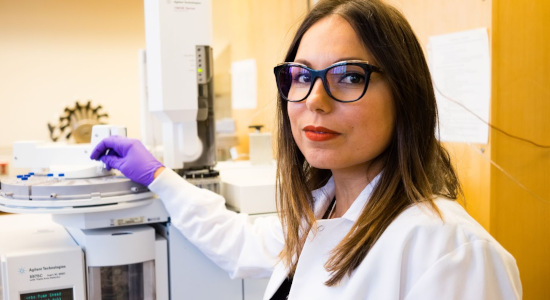The Lipid and Metabolite Biomarker Lab
The Lipid and Metabolite Biomarker Lab is a new state-of-the-art laboratory at the Globe Institute, exclusively dedicated to the study of lipids and metabolites. At the lab, we provide new insights about our species evolution through the analysis of ancient lipids and metabolites.

Do you have questions or want to explore the lipids in your samples?
Write to ainara.sistiaga@sund.ku.dk
The Lipid and Metabolite Biomarker Lab consists of our ultra-clean molecular laboratory. It only uses combusted (450-550ºC) glassware and highest purity organic solvents.
Funded by the Ministry of Higher Education and Science and the DNRF, the Lipid Lab is also equipped with a new generation Gas Chromatograph coupled to a Flame Ionisation detector and a Mass Spectrometer detector located at the geochemistry laboratory at the Denmark and Greenland Geological Survey (GEUS).
Our GC-FID/MSD is equipped with the MassHunter software from Agilent and the NIST20 library that facilitates data analysis and biomarker identification.
Total lipid extract analysis (105 min)
Fraction lipid analysis (Several runs of 105 min)
Depending on the scientific questions, data analysis can be a simple or a very complex task. Some very complex samples might require extra fractionation, runs the GC-MS and more complex molecular identification.
The term biomarker can be applied to any class of natural biomolecule that can be traced to its origin. Although modern applications include a wide range of molecules to trace drugs, pesticides or diseases, lipids are the most widely studied group of compounds in organic geochemistry. Lipids are a large group of compounds produced by organisms, which are insoluble in water but readily extractable in non-polar solvents.
Biomarkers are complex molecular fossils made of carbon, hydrogen, and other elements and originated from formerly living organisms. They are often very robust molecules that can survive for hundreds of millions of years and can be found in sediments, rocks and archaeological remains. Their principal identifying characteristics reflect little or no change from their parent organic molecules during sedimentation and early burial (The Biomarker Guide Vol. 1, Peters et al., 2005).
Biomarkers are useful, particularly those with specific biological sources, because their complex structure reveals more information about their origin than other compounds. These biomolecules encode information about past environments, biodiversity, element cycling, sediment and water chemistry, and temperature changes. Biomarkers can also provide insights into our species evolution, its diet, diseases, microbiomes and lifestyle.
 Maria Sistiaga sampling at Olduvai.
Maria Sistiaga sampling at Olduvai.
The types of biomarkers we analyze at the lab can be separated into three categories:
Environmental biomarkers
- Leaf waxes - Dominant vegetation and ecosystem shifts
- Terrestrial and aquatic - Terrestrial and macrophytic input
- Microbial lipids - Paleoenvironmental reconstruction based on microbial biosignatures
- Arctic Sea Ice Dynamics - Reconstruction of Arctic paleo sea ice
- Paleothermometry - Archaeal and bacterial lipids as proxies for paleo temperatures (soon possible)
- Biomass burning biomarkers - Polycyclic aromatic hidrocarbons (PAHs) and other molecules associated with fire
Anthropogenic biomarkers
- Faecal biomarkers - Sourcing of faecal matter, paleodiet and settlement history
- Lipids in potsherds - Production and use of portsherds
- Biological source identification - Sourcing and material identification
Microbiome-associated biomarkers
- Cholesterol and bile acid metabolites - Analysis of metabolic products of the cholesterol metabolism
- Short chain fatty acids - Analysis of microbially regulated short chain fatty acids with FID
- GC-based faecal metabolomics - Analysis of small molecules from the gut by gas chromatography-mass spectrometry
Summons, R. E. (2014). The exceptional preservation of interesting and informative biomolecules. The Paleontological Society Papers, 20, 217-236
Summons, R. E., Welander, P. V., & Gold, D. A. (2022). Lipid biomarkers: molecular tools for illuminating the history of microbial life. Nature Reviews Microbiology, 20(3), 174-185

